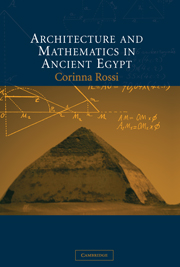Book contents
- Frontmatter
- Contents
- List of illustrations
- List of tables
- Preface
- Acknowledgments
- List of abbreviations
- Part I Proportions in ancient Egyptian architecture
- Part I Ancient Egyptian sources: construction and representation of space
- Introduction to Part II: Tradition and variations in ancient Egyptian art and architecture
- 3 Documents on the planning and building process
- 4 Foundation rituals
- Conclusion to Part II: From the plan to the building
- Part III The geometry of pyramids
- Conclusion to Part III: Interpreting the slope of pyramids
- An overview
- Appendix: List of Old and Middle Kingdom true pyramids
- Bibliography
- Index
Introduction to Part II: Tradition and variations in ancient Egyptian art and architecture
Published online by Cambridge University Press: 27 February 2010
- Frontmatter
- Contents
- List of illustrations
- List of tables
- Preface
- Acknowledgments
- List of abbreviations
- Part I Proportions in ancient Egyptian architecture
- Part I Ancient Egyptian sources: construction and representation of space
- Introduction to Part II: Tradition and variations in ancient Egyptian art and architecture
- 3 Documents on the planning and building process
- 4 Foundation rituals
- Conclusion to Part II: From the plan to the building
- Part III The geometry of pyramids
- Conclusion to Part III: Interpreting the slope of pyramids
- An overview
- Appendix: List of Old and Middle Kingdom true pyramids
- Bibliography
- Index
Summary
Ancient Egyptian architects certainly followed a number of rules in the construction of their buildings, but both the nature and the function of these rules must be clarified. Identifying them just as mathematical formulae might be reductive and inappropriate. In general, continuity (real or pretended) is a striking element of ancient Egypt, where revivals of ancient features took place from time to time in both language and the arts. Although forms and tastes did not remain unchanged during the more than thirty centuries of ancient Egyptian history, the link with the past, with what had been done by the ancestors, continued to play a significant role. A good example is the religious text engraved by Shabaka, king of the Twenty-fifth Dynasty, on a stele now at the British Museum, which is said to have been copied from an ancient, worm-eaten document. The style of the text is archaic and resembles the Old Kingdom Pyramid Texts, but it is now generally assumed that it is a much later composition, perhaps even dating to Shabaka's time.
Concerning the arts, it seems that there were archives of traditional sources and models which could be consulted and used. The drawing of a shrine on papyrus, in black ink over a red square grid (fig. 47), might be the only surviving original example of this type of document. The existence of models may also be deduced by several observations.
- Type
- Chapter
- Information
- Architecture and Mathematics in Ancient Egypt , pp. 92 - 95Publisher: Cambridge University PressPrint publication year: 2004



